85-year-old WIM Edith Krizsán-Bilek is a pioneer in women’s chess. She has been playing all her life. In 1958, Krizsán-Bilek won the Hungarian Women’s Chess Championship and has represented Hungary in several Chess Olympiads, winning individual and team medals.
Even now, she travels to Cyprus regularly, giving talks to kids and teaching chess, accompanied by friends and family. This afternoon she attended the fifth round of the Cyprus Women’s Grand Prix, inspiring all the players with her presence. It was a special moment for everyone involved when she was applauded by the players at the start of the round.
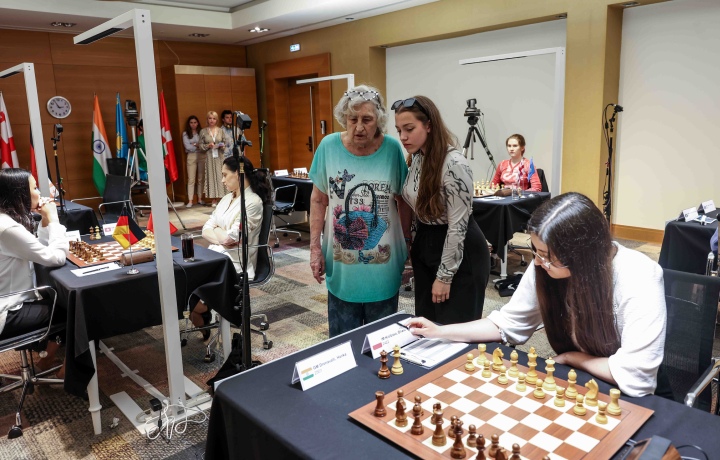
The hero of the round was Harika Dronavalli. Supported by a few Indian fans who came to cheer her on, she defeated Oliwia Kiolbasa with Black and now shares the lead with Tan Zhongi and Lagno, who could only draw their games.
GM Lagno, Kateryna vs GM Goryachkina, Aleksandra (0,5-0,5)
The most important game of the round and, maybe, of the entire series. Goryachkina and Lagno have faced each other nine times in classical games, including two games during the current Grand Prix series.
With two wins and seven draws, Goryachkina outscores Lagno by the slightest of margins, although it must be said that Lagno has had her fair share of victories in blitz and rapid.
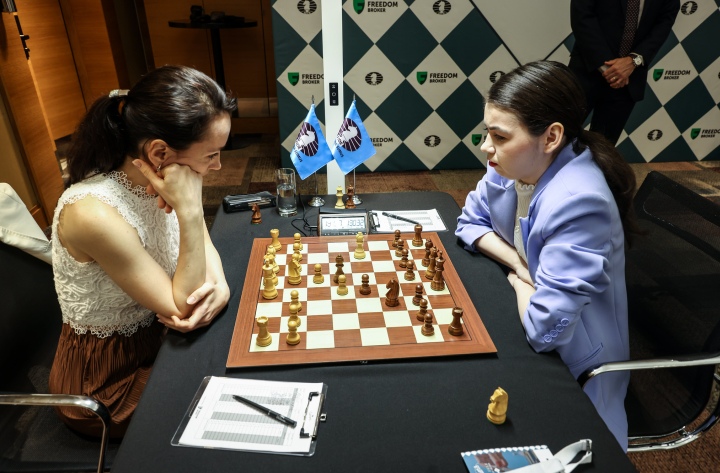
Today’s game was a theoretical battle in the 4.d3 Berlin defence in the Ruy Lopez. Instead of 5…0-0, which Goryachkina chose against Lagno a month ago in New Delhi, she decided to mix things up and go for 5…Nd4, an active line achieving the two bishops and initiative in exchange for a severely weakened pawn structure.
All the games played in this line have ended in draws, including a 2019 encounter between Nakamura and Aronian or more recent games played by Giri or Kryvoruchko.
Lagno had prepared a new idea, 13.Qd3, but as usual, Goryachkina had done her homework and uncorked a very nice exchange sacrifice to keep the balance.
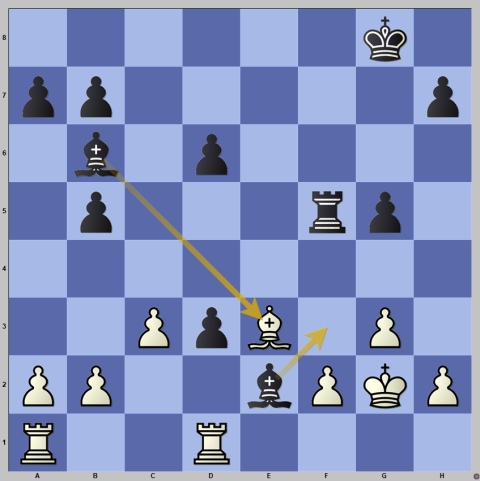
According to the engine, Aleksandra could have even gone for more had she played 22…Bxe3 instead of 22…Bf3+. The idea is to keep playing an exchange down and prioritize the centralization of the black king. Both players discussed this and other variations after the game while they were undergoing the fair-play postgame procedures.
IM Kiolbasa, Oliwia vs GM Dronavalli, Harika (0-1)
It’s hard to say for sure, but judging by the amount of time that Kiolbasa spent on the opening, it seems she was surprised by the Neo-Arkhangelsk variation of the Ruy Lopez that Harika played against her this afternoon.
Although it’s not one of her main repertoire lines, she did play it recently against Zhu Jiner in the 2023 Munich leg of the Grand Prix.
In this afternoon’s game, she can safely say that her work on the opening has been successful.
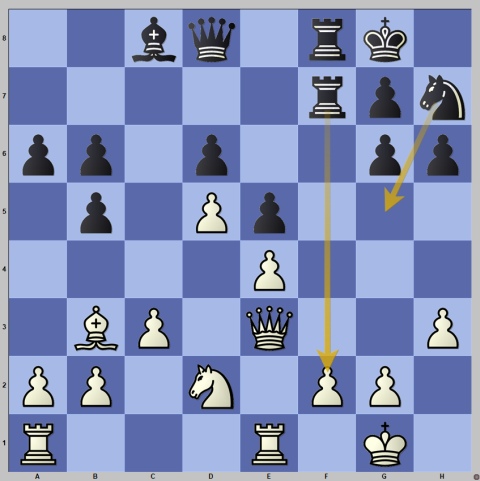
Although Black has two sets of doubled pawns from the opening, it’s easy to see that only Harika is fighting for the advantage: strong doubled rooks on the f-file and clear attacking chances.
Harika could have cashed in with 22…Rxf2, winning a pawn but losing part of her positional advantage. Instead, she preferred to play for the attack, especially taking into account Kiolbasa’s time trouble. With precise and aggressive play, she took down the point, cruising into joint lead with 3.5/5.
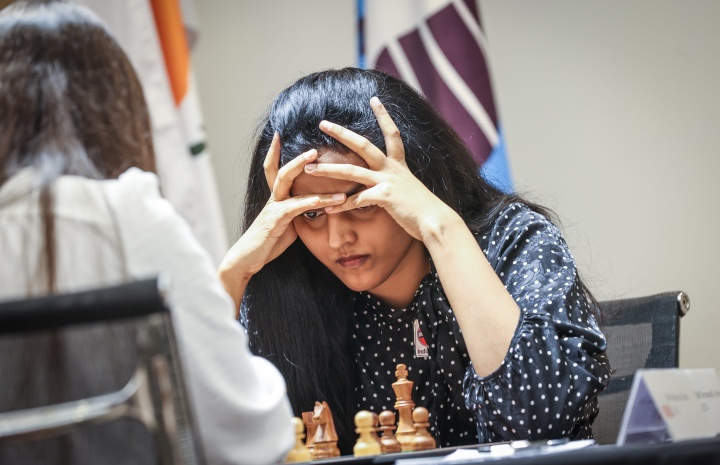
In her postgame interview, she was joined by a team of local Indian supporters, who arrived just at the right moment to see her convert her advantage. “I’m not thinking much about the standings; I’m just trying to play my own chess and give my best,” were her wise words after the game.
IM Shuvalova, Polina vs GM Khotenashvili, Bella (0’5-0’5)
According to my database, Shuvalova and Khotenashvili had only played once together, a draw in the 2022 World Rapid Championship.
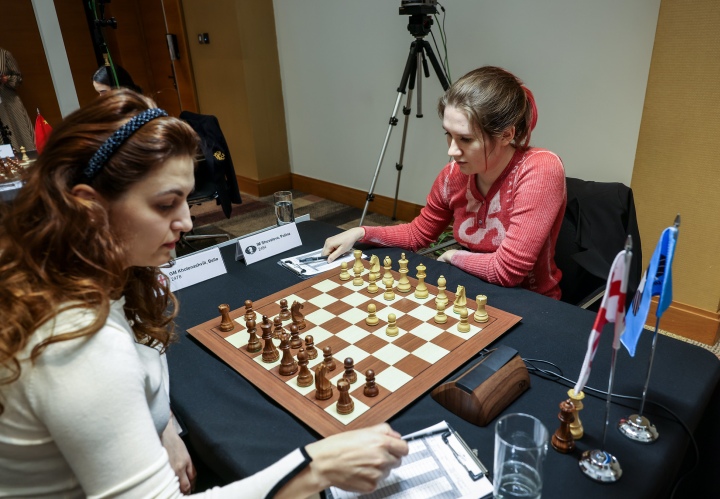
This afternoon, Shuvalova’s opening preparation was spot on. In a dangerous side-line of the Grunfeld defence, she played fast and with a lot of confidence, blitzing out her attacking moves and putting maximum pressure on her Georgian opponent.
By advancing her h-pawn to h6, she created a very dangerous wedge in Khotenashvili’s castled kingside – a decisive tactical option for a back-rank mate.
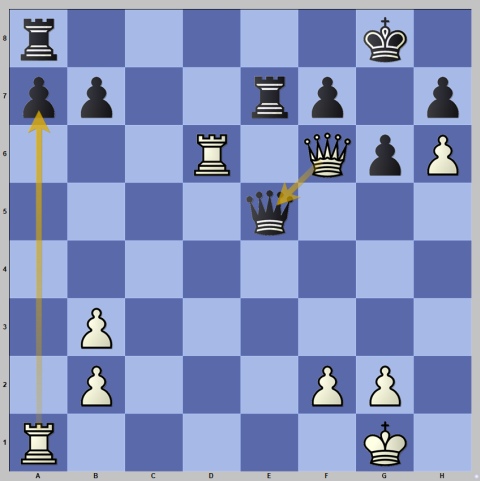
The key moment was move twenty-seven. Instead of exchanging queens, 27.Rxa7 straight away was much better, reducing Black’s defensive opportunities in the double rook ending. The engine assesses the endgame as won for White, but Shuvalova chose a different option, grabbing a pawn but substantially reducing her winning chances, and the game finally ended in a draw.
GM Dzagnidze, Nana vs IM Assaubayeva, Bibisara (0.5-0.5)
Assaubayeva has demonstrated time and time again her strength on the black side of the King’s Indian defence, so it was no surprise to see the experienced Dzagnidze select one of the many offbeat side-lines with double fianchetto.
The idea was to take her opponent out of the book as soon as possible and make her think for herself from the get-go. The plan was successful: Assaubayeva didn’t seem at home in the opening phase, spending much more time than usual.
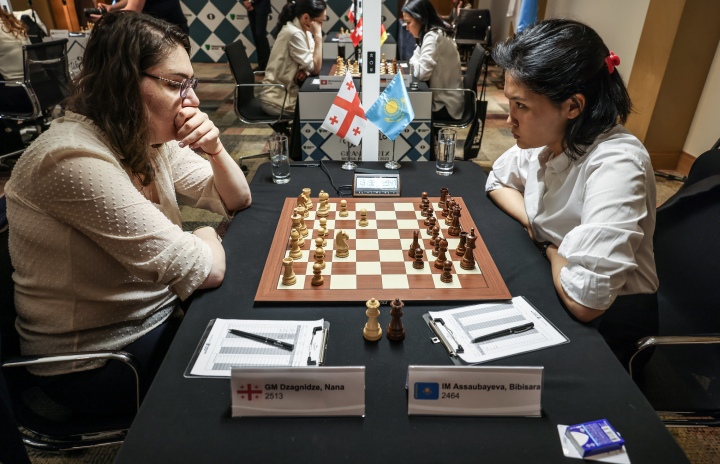
Dzagnidze got a small edge out of the middlegame: control over the central dark squares and potentially a two vs one pawn majority on the queenside. However, Assaubayeva defended well, keeping the disadvantage at a minimum. Approaching the time control, Assaubayeva misplayed her position in her opponent’s time trouble, landing in a very dangerous queen plus knight vs queen plus bishop endgame, totally lost according to the engines.
Nonetheless, inaccurate play by Dzagnidze combined with strong defence by Assaubayeva earned the latter a well-deserved half point.
IM Mammadzada, Gunay vs GM Tan, Zhongyi (0,5-0,5)
In their first game together, Mammadzada went for the Catalan Opening with 3.g3, sidestepping Tan Zhongyi’s Queen’s Indian defence.
After a few theoretical moves, Mammadzada forfeited her Catalan bishop in exchange for what seemed to be a superior pawn structure. However, as in other games in this event, the top Azerbaijan female player was spending too much time on the clock.
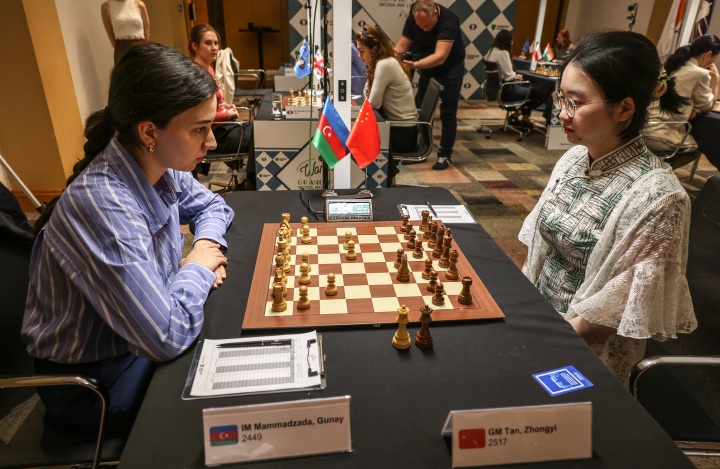
With her opponent under severe time pressure, Tan Zhongyi exchanged all the pieces and forced a rook ending with a very dangerous passed pawn. Mammadzada was in danger, but she calculated with precision and managed to force a draw by move repetition.
GM Kosteniuk, Alexandra vs WGM Wagner, Dinara (0,5-0,5)
In a Sicilian Rossolimo, Wagner aggressively went for Sveshnikov-style play with 9…g5 and 11…f5. But the idea backfired, and soon she had lost her castled-king rights, and her position became very shaky.
According to the engine, Kosteniuk could have secured a decisive advantage with 18.Bxf4, sacrificing an exchange for a pawn and a strong attack, but Kosteniuk preferred to play it safe and not give her opponent any opportunities.
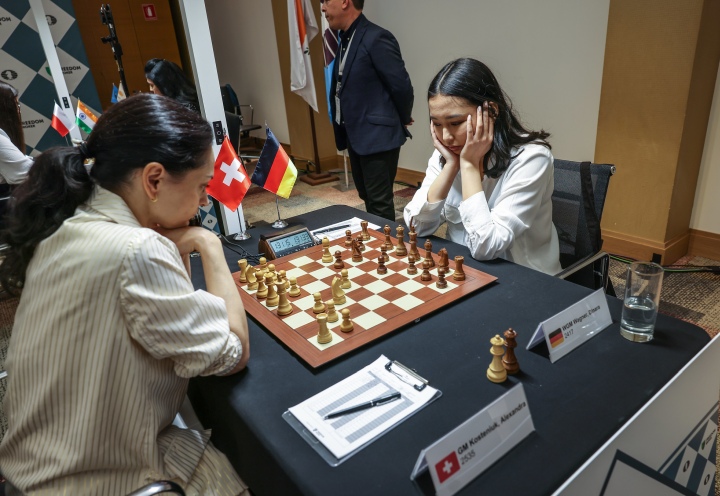
However, Wagner fought back tenaciously, to a point where Kosteniuk found herself in trouble. In a mutual time scramble, both played inaccurately, and a draw was agreed when the queens were exchanged.
In her postgame interview, Wagner reflected upon her improved performance in Cyprus, with regard to previous Grand Prix events. “In Astana and in Munich, I was not as confident as I am now. I would say it’s all about confidence, and it comes with the experience of playing these strong tournaments.”
Standings after Round 5
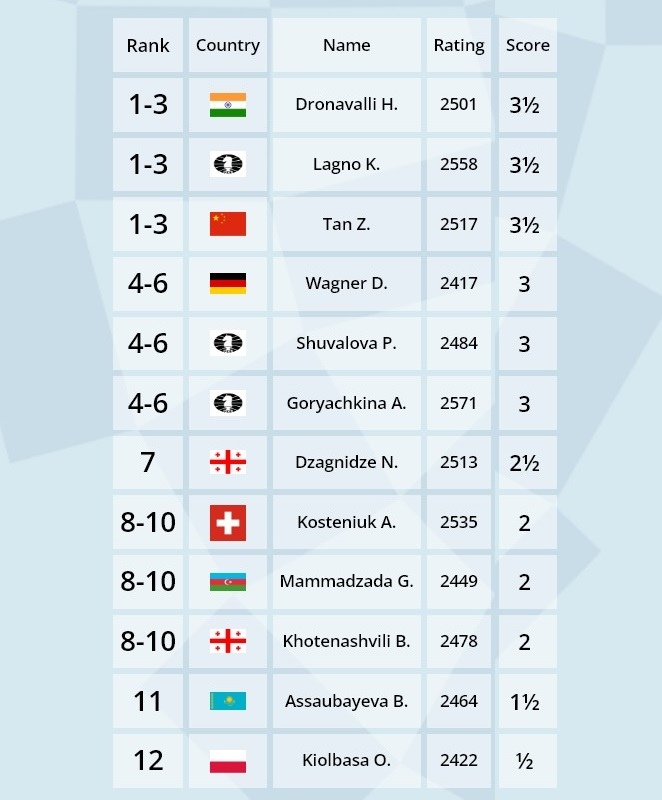
Text: IM Michael Rahal (Nicosia, Cyprus)
Photos: Mark Livshitz
About Freedom Finance Europe
Freedom Finance Europe, a subsidiary of Freedom Holding Corp., is a leading European stockbroker. The company’s Freedom24 web and mobile app investment platform provides traders with direct access to 15 global stock exchanges, including NYSE, Nasdaq, LSE, Euronext and others. Freedom Finance Europe is licensed by Cyprus Securities and Exchange Commission (CySEC) with the right to cater clients from EU and EEA countries. The company is rated “B/B” by S&P Global Ratings. Headquartered in Limassol, the company has tied agents and representative offices in Berlin, Madrid, Paris, Milan, Vienna, Warsaw, and Athens.
More information: https://www.freedom24.com/








